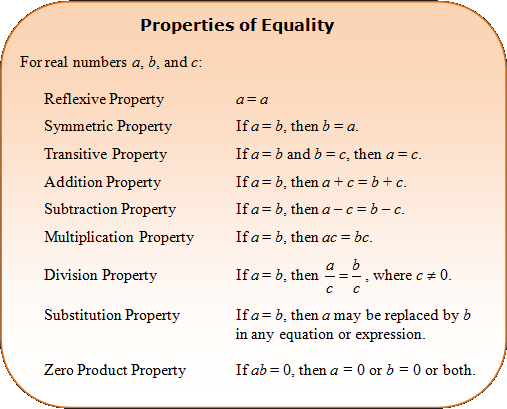Unit 2: Algebraic Thinking
Unit 2: Algebraic Thinking

Overview
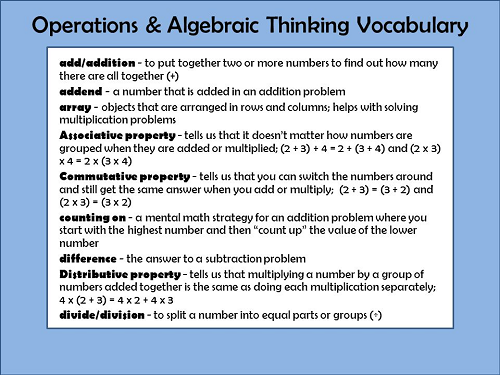
Unit 2: Algebraic Thinking
This unit emphasizes strategies used to solve equations and understand and solve inequalities.
Unit Focus
Reading Process
Vocabulary Development
- The student will use new vocabulary that is introduced and taught directly.
- The student will listen to, read, and discuss familiar and conceptually challenging text.
- The student will relate new vocabulary to familiar words.
Writing Process Strand
Prewriting
- To develop a personal, organizational style, the student will prewrite using organizational strategies and tools (e.g., technology, spreadsheet, outline, chart, table, graph, Venn diagram, web, story map, plot pyramid).
Linear Equations and Inequalities
- Solve linear equations in one variable that include simplifying algebraic expressions.
- Identify and apply the distributive, associative, and commutative properties of real numbers and the properties of equality.
- Solve literal equations for a specified variable.
- Solve and graph simple and compound inequalities in one variable and be able to justify each step in a solution.
Mathematical Reasoning and Problem Solving
- Use various problem-solving strategies, such as drawing a diagram, making a chart, guessing- and checking, solving a more straightforward problem, writing an equation, working backward, and creating a table.
Vocabulary
Continue to the Next Page
Lesson 1: Solving Equations

Lesson Overview
Algebraic thinking provides tools for looking at situations. You can state, simplify, and show relationships through algebraic thinking. When combining algebraic symbols with algebraic thinking, you can record information or ideas and gain insights into solving problems. In this lesson, you will use what you have learned to solve equations and inequalities on a more advanced level.
Reading Process
- The student will use new vocabulary that is introduced and taught directly.
- The student will listen to, read, and discuss familiar and conceptually challenging text.
- The student will relate new vocabulary to familiar words.
Writing Process
- To develop a personal organizational style, the student will prewrite using organizational strategies and tools (e.g., technology, spreadsheet, outline, chart, table, graph, Venn diagram, web, story map, plot pyramid).
Algebra Body of Knowledge
Linear Equations and Inequalities
- Solve linear equations in one variable that include simplifying algebraic expressions.
- Identify and apply the distributive, associative, and commutative properties of real numbers and the properties of equality.
- Solve and graph simple and compound inequalities in one variable and be able to justify each step in a solution.
Mathematical Reasoning and Problem Solving
- Use various problem-solving strategies, such as drawing a diagram, making a chart, guessing- and checking, solving a more straightforward problem, writing an equation, working backward, and creating a table.
Lesson Reading
Continue to the Next Page
Lesson 2: The Distributive Property

Lesson Overview
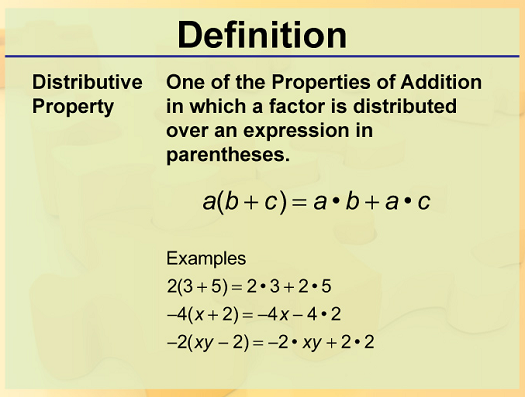
Lesson 2: The Distributive Property
Reading Process
Vocabulary Development
- The student will use new vocabulary that is introduced and taught directly.
- The student will listen to, read, and discuss familiar and conceptually challenging text.
- The student will relate new vocabulary to familiar words.
Writing Process
Prewriting
- To develop a personal organizational style, the student will prewrite using organizational strategies and tools (e.g., technology, spreadsheet, outline, chart, table, graph, Venn diagram, web, story map, plot pyramid).
Algebra Body of Knowledge
Linear Equations and Inequalities
- Solve linear equations in one variable that include simplifying algebraic expressions.
- Identify and apply the distributive, associative, and commutative properties of real numbers and the properties of equality.
- Solve and graph simple and compound inequalities in one variable and be able to justify each step in a solution.
Mathematical Reasoning and Problem Solving
- Use various problem-solving strategies, such as drawing a diagram, making a chart, guessing- and checking, solving a more straightforward problem, writing an equation, working backward, and creating a table.
Lesson Reading
Continue to the Next Page
Lesson 3: Solving Equations with Variables on Both Sides

Lesson Overview
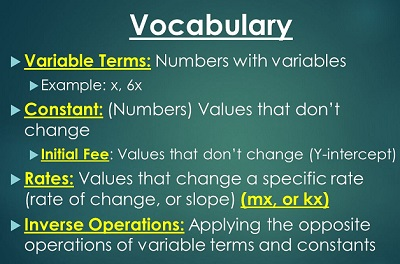
Reading Process Strand
Vocabulary Development
- The student will use new vocabulary that is introduced and taught directly.
- The student will listen to, read, and discuss familiar and conceptually challenging text.
- The student will relate new vocabulary to familiar words.
Writing Process
Prewriting
- To develop a personal, organizational style, the student will prewrite using organizational strategies and tools (e.g., technology, spreadsheet, outline, chart, table, graph, Venn diagram, web, story map, plot pyramid).
Algebra Body of Knowledge
Linear Equations and Inequalities
- Solve linear equations in one variable that include simplifying algebraic expressions.
Lesson Reading
Continue to the Next Page
Lesson 4: Graphing Inequalities on a Number Line

Lesson Overview
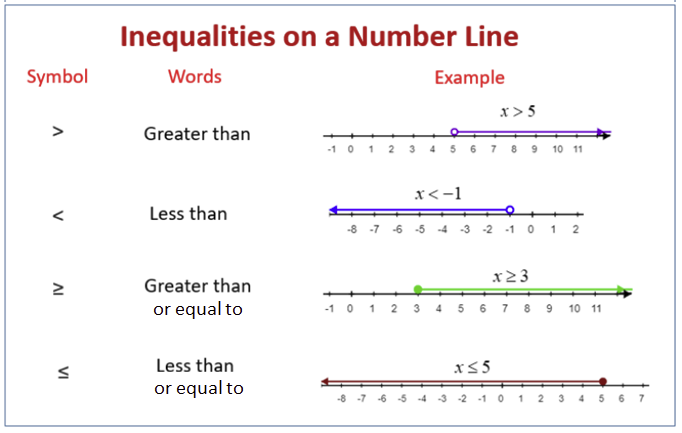
Reading Process
Vocabulary Development
- The student will use new vocabulary that is introduced and taught directly.
- The student will listen to, read, and discuss familiar and conceptually challenging text.
- The student will relate new vocabulary to familiar words.
Writing Process Strand
Prewriting
- To develop a personal, organizational style, the student will prewrite using organizational strategies and tools (e.g., technology, spreadsheet, outline, chart, table, graph, Venn diagram, web, story map, plot pyramid).
Algebra Body of Knowledge
Linear Equations and Inequalities
- Solve linear equations in one variable that include simplifying algebraic expressions.
- Identify and apply the distributive, associative, and commutative properties of real numbers and the properties of equality.
- Solve and graph simple and compound inequalities in one variable and be able to justify each step in a solution.
Mathematical Reasoning and Problem Solving
- Use various problem-solving strategies, such as drawing a diagram, making a chart, guessing- and checking, solving a more straightforward problem, writing an equation, working backward, and creating a table.
Lesson Reading
Continue to the Next Page
Lesson 5: Formulas Using Variables

Lesson Overview
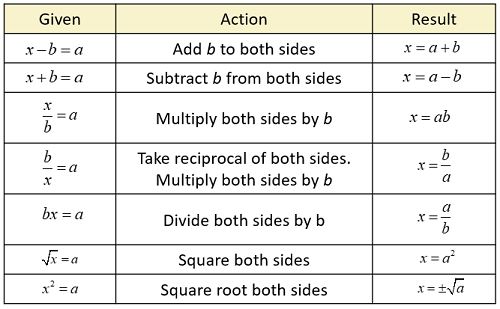
Reading Process Strand
Formulas using variables are mathematical expressions that represent relationships between different quantities. These formulas typically involve one or more variables, which are placeholders for unknown or varying values. By substituting specific values for these variables, the formulas allow for calculations and predictions in a wide range of mathematical and scientific contexts. They provide a systematic way to describe patterns, relationships, and laws governing various phenomena, making them essential tools in problem-solving and analysis.
Vocabulary Development
- The student will use new vocabulary that is introduced and taught directly.
- The student will listen to, read, and discuss familiar and conceptually challenging text.
Algebra Body of Knowledge
Linear Equations and Inequalities
- Solve literal equations for a specified variable.
Mathematical Reasoning and Problem Solving
- Use various problem-solving strategies, such as drawing a diagram, making a chart, guessing- and checking, solving a more straightforward problem, writing an equation, working backward, and creating a table.
Lesson Reading
